Arborvitae Winter Care: What To Do About Winter Damage To Arborvitae
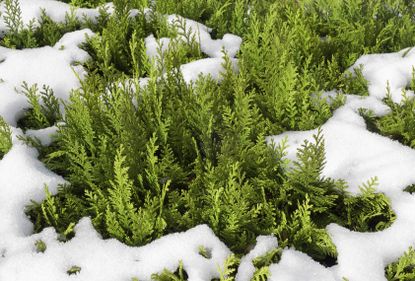

Trees can be injured by winter weather. This is especially true for needled trees since the needles stay on the trees all winter. If you have arborvitae in your yard and you live in a cold climate, you have probably seen that they occasionally suffer winter damage. Read on for information about winter injury on arborvitae bushes.
Winter Damage to Arborvitae
Winter injury on arborvitae bushes is not uncommon. Desiccation, or drying out, is one important cause of winter damage to arborvitae. The arborvitae dry out when the needles lose water faster than they can take it up. Arborvitae needles transpire moisture even in winter, and uptake water from the ground to replace the lost moisture. When the ground freezes below the root system, it cuts off the water supply.
Why are My Arborvitae Turning Brown?
Desiccation can lead to arborvitae winter burn. If the foliage is buried under snow, it is protected. But unprotected needles will suffer from winter burn, which turns them brown, gold or even white, particularly on the south, southwest, and windward sides of plants. The actual discoloration, however, can be caused by a number of factors in addition to desiccation and can be fairly dramatic. These include:
- strong wind
- bright sun
- deep, hard frost
- biting cold
- salt used on sidewalks and roadways
If the winter burn is severe, the entire arborvitae may brown and die. You may notice symptoms as the damage is occurring, but often the burn damage looks even worse later, as temperatures rise in early spring. It’s best not to make any rapid decisions about whether or not you can save the tree. Simply wait for spring and you can easily tell whether the arborvitae is alive.
Arborvitae Winter Care
You can prevent desiccation by watering the ground thoroughly all through the growing season, right up through autumn. Give the shrubs more water on warm days during the winter. Arborvitae winter care also includes a thick layer of mulch to protect roots. Use up to 4 inches (10 cm.). In addition to mulch, you may need to wrap evergreens in burlap or other material for winter protection if your winters are particularly severe. If you do, don’t wrap too tight or cover the plants too completely. Be sure to give the trees room to breathe and exposure to natural light.
Gardening tips, videos, info and more delivered right to your inbox!
Sign up for the Gardening Know How newsletter today and receive a free download of our most popular eBook "How to Grow Delicious Tomatoes."

Teo Spengler has been gardening for 30 years. She is a docent at the San Francisco Botanical Garden. Her passion is trees, 250 of which she has planted on her land in France.
-
 Urban Beekeeping Guide: Top Tips For Raising Bees In The City
Urban Beekeeping Guide: Top Tips For Raising Bees In The CityUrban beekeeping can be a rewarding and appreciated pastime, but first be sure it’s legal in your city and learn the ropes of beekeeping.
By Mary Ellen Ellis
-
 2024 Plant Of The Year: Why Experts Say Philodendron Is The “It” Plant Of The Year
2024 Plant Of The Year: Why Experts Say Philodendron Is The “It” Plant Of The YearWe aren’t surprised that philodendron was designated the plant of the year. Versatile, easy-care and lovely, it’s the houseplant of the year 2024!
By Bonnie L. Grant
-
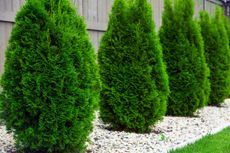 Arborvitae Plant Varieties: Getting To Know Different Types Of Arborvitae
Arborvitae Plant Varieties: Getting To Know Different Types Of ArborvitaeArborvitae are perfect for many landscapes used as single focal points or as part of a windbreak or privacy fence. If you need a different size or are interested in various cultivars, check out the following varieties of arborvitae in this article.
By Becca Badgett
-
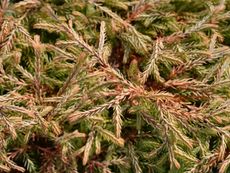 Mr. Bowling Ball Arborvitae: Tips For Growing A Mr. Bowling Ball Plant
Mr. Bowling Ball Arborvitae: Tips For Growing A Mr. Bowling Ball PlantPlant names often give a glimpse into the form, color, size and other characteristics. Mr. Bowling Ball Thuja is no exception. The resemblance to its namesake as a domed plant that snugs into awkward spaces makes this arborvitae an attractive addition. Learn more here.
By Bonnie L. Grant
-
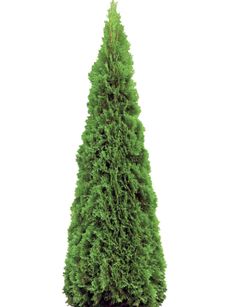 Emerald Green Arborvitae Info: Tips On Growing Emerald Green Arborvitae
Emerald Green Arborvitae Info: Tips On Growing Emerald Green ArborvitaeThe key to successfully using arborvitae in the landscape is selecting the proper varieties. This article is about the popular variety of arborvitae commonly known as "Emerald Green" or "Smaragd." Click here for Emerald Green arborvitae information.
By Darcy Larum
-
 Caring For Thuja Evergreens: How To Grow A Green Giant Arborvitae
Caring For Thuja Evergreens: How To Grow A Green Giant ArborvitaeFew garden plants grow faster or taller than the Thuja Green Giant. This enormous and vigorous evergreen can quickly tower above you and, in a few years, grow taller than your house. For more information about Thuja Green Giant plants, click here.
By Teo Spengler
-
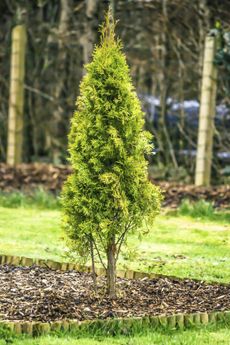 Fertilizing Arborvitae – When And How To Fertilize An Arborvitae
Fertilizing Arborvitae – When And How To Fertilize An ArborvitaeBeloved for their fast growth, arborvitae often require fertilizer to thrive. It isn?t difficult to begin fertilizing arborvitae. Click on this article to learn how to fertilize an arborvitae and the type of fertilizer for arborvitae.
By Teo Spengler
-
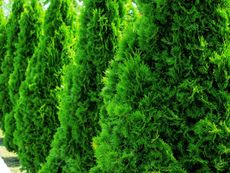 Arborvitae: Ultimate Care And Growing Guide
Arborvitae: Ultimate Care And Growing GuideArborvitae is a versatile evergreen in the landscape. Arborvitae trees are hardy and can grow tall for screening, or kept trimmed as a hedge.
By Bonnie L. Grant